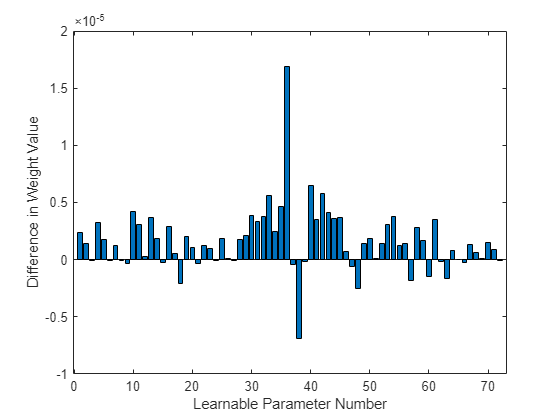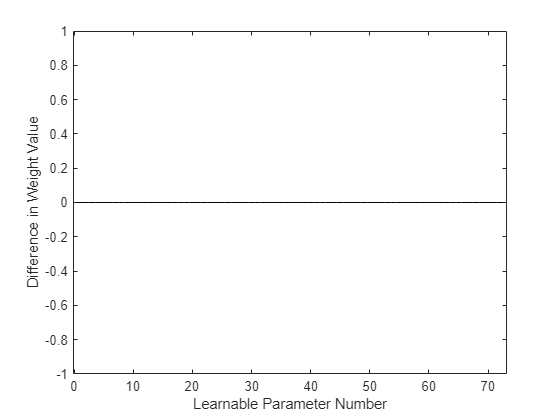deep.gpu.deterministicAlgorithms
Set determinism of deep learning operations on the GPU to get reproducible results
Since R2024b
Syntax
Description
previousState = deep.gpu.deterministicAlgorithms(newState)1 (true) or 0
(false) before changing the state according to the input
newState. If newState is 1
(true), then subsequent calls to GPU deep learning operations use only
deterministic algorithms. This function requires Parallel Computing Toolbox™.
state = deep.gpu.deterministicAlgorithms1 (true) or 0
(false). If state is 1
(true), then subsequent calls to GPU deep learning operations use only
deterministic algorithms.
Tip
Use this function only if you require your GPU deep learning operations to be exactly reproducible because using only deterministic algorithms can slow down computations.
This function only controls the algorithms selected by the NVIDIA® cuDNN library. To enable reproducibility, you must also control other sources of randomness, for example, by setting the random number generator and seed. In most cases, setting the random number generator and seed on the CPU and GPU using the
rngandgpurng(Parallel Computing Toolbox) functions, respectively, is sufficient. For more information, see Limitations and Tips.
Examples
Input Arguments
Limitations
This function only affects deep learning computations on the GPU in MATLAB®. It does not affect:
Deep learning operations on a CPU, for example, training a network using the
trainnetfunction with theExecutionEnvironmenttraining option set to"cpu"or"parallel-cpu".Deep learning code generated using GPU Coder™ or MATLAB Coder™.
Predictions using the
predictandminibatchpredictfunctions when theAccelerationoption is set to"mex".Deep learning operations in Simulink®.
When using only deterministic algorithms, computations can be slower.
As the NVIDIA algorithm selection depends on several factors, including the hardware and the current GPU memory usage, your workflow might not give identical results on different GPUs.
Training a network is not reproducible, even if you use this function and set the random number generator and seed, if:
You use the
trainnetfunction with thePreprocessingEnvironmenttraining option set to"background"or"parallel".You train a network using a
minibatchqueueobject with thePreprocessingEnvironmentproperty set to"background"or"parallel".You train a network that contains a
maxPooling1dLayer,maxPooling2dLayer, ormaxPooling3dLayer.You train a deep learning model defined as a function that uses the
maxpoolfunction.
In R2025a: Training and inference with a transformer network (a network that contains a
selfAttentionLayer,anattentionLayer, or uses theattentionoperation) might not be reproducible, even if you use this function and set the random number generator and seed, if these conditions are met:You use an Ampere architecture GPU or newer (compute capability must be at least 8.0).
You train or make predictions using single precision. By default, the software performs computations using single-precision, floating-point arithmetic when you train a neural network using the
trainnetfunction and when you use prediction or validation functions with adlnetworkobject with single-precision learnable and state parameters.You do not return the attention scores (also known as the attention weights).
You do not use dropout (the dropout probability must equal zero) when you train.
You do not pad the input to attention layers or operations, or you only use right padding.
The size of the channel dimension of the queries and keys divided by the number of attention heads is less than 128.
Tips
Sources of randomness in your deep learning workflow can include:
Learnable parameter and state value initialization — Initialization functions that sample from a distribution using random numbers generated on the CPU.
Data shuffling during training — If the
Shuffletraining option is set to"once"or"every-epoch", thetrainnetfunction shuffles the training data using random numbers generated on the CPU.Dropout layers — If you are training using a CPU, dropout layers generate random numbers on the CPU. If you are training using a GPU, dropout layers generate random numbers on the GPU.
Custom layers — The code inside your function layer dictates where the random numbers are generated. For example,
rand(10)generates random numbers on the CPU whilerand(10,"gpuArray")generates random numbers on the GPU.
If you are performing deep learning operations in parallel, for example, by using the
trainnetfunction with theExecutionEnvironmentoption set to"parallel-gpu", then set the random number generator and seed on each of the workers. For more information, see Control Random Number Streams on Workers (Parallel Computing Toolbox).You can change the default algorithm and seed for the random number generator from the MATLAB Settings Window window. To ensure that
rng("default")uses the same algorithm and seed in different MATLAB sessions, ensure that the sessions have the same default algorithm and seed preferences. Alternatively, you can avoid using the preferences by specifying the seed and algorithm. For example, callrng("twister")to use the Mersenne Twister algorithm with a seed of 0.
Version History
Introduced in R2024b
See Also
rng | gpurng (Parallel Computing Toolbox) | trainnet
Topics
- Generate Random Numbers That Are Repeatable
- Random Number Streams on a GPU (Parallel Computing Toolbox)
- Control Random Number Streams on Workers (Parallel Computing Toolbox)
- Reproduce Network Training on a GPU

